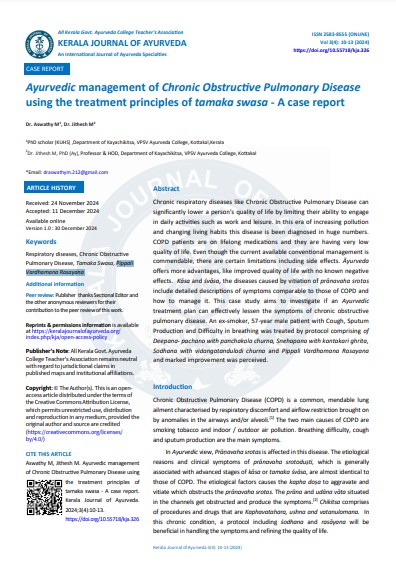Ayurvedic management of Chronic Obstructive Pulmonary Disease using the treatment principles of tamaka swasa - A case report
DOI:
https://doi.org/10.55718/kja.326Keywords:
Respiratory diseases, Chronic Obstructive , Pulmonary Disease, , Tamaka Swasa, Pippali Vardhamana RasayanaAbstract
Chronic respiratory diseases like Chronic Obstructive Pulmonary Disease can significantly lower a person's quality of life by limiting their ability to engage in daily activities such as work and leisure. In this era of increasing pollution and changing living habits this disease is been diagnosed in huge numbers. COPD patients are on lifelong medications and they are having very low quality of life. Even though the current available conventional management is commendable, there are certain limitations including side effects. Āyurveda offers more advantages, like improved quality of life with no known negative effects. Kāsa and śvāsa, the diseases caused by vitiation of prāṇavaha srotas. include detailed descriptions of symptoms comparable to those of COPD and how to manage it. This case study aims to investigate if an Ayurvedic treatment plan can effectively lessen the symptoms of chronic obstructive pulmonary disease. An ex-smoker, 57-year male patient with Cough, Sputum Production and Difficulty in breathing was treated by protocol comprising of Deepana- pachana with panchakola churna, Snehapana with kantakari ghrita, Sodhana with vidangatanduladi churna and Pippali Vardhamana Rasayana and marked improvement was perceived.
References
Global initiative for chronic obstructive lung disease - Global strategy for the diagnosis, management & prevention of COPD. 2023. available at www.goldcopd.com. The Global Strategy for Diagnosis, Management and Prevention of COPD (updated 2020), the Pocket Guide (updated 2020); https://goldcopd.org
TripathiBrahmananda.,Dr,editor.Charakasamhita. Chikitsasthan. 2002;17(45):621. [Google Scholar]
Bestall J C, Paul E A, Garrod R, Garnham R, Jones P W, Wedzicha J A. Usefulness of the Medical Research Council (MRC) dyspnoea scale as a measure of disability in patients with chronic obstructive pulmonary disease. Thorax. 1999; 54(7): 581-6
Prof. Srikanra Moorthy , Shargadhara Samhitha of Shargadhara, madhyama khanda 6th edition, Varanasi ; chowkambha Sanskrit series ; 2006, 6/13-14
P.M. Govindan vaidyan. Ashtanga Hrdaya of Vagbhata, chikitsa sthana. Edition reprint 17. Devi book stall, Kodungallur. 2016; 3/59-61,102 p.
P.M. Govindan vaidyan. Ashtanga Hrdaya of Vagbhata, sutra sthana. Edition reprint 17. Devi book stall, Kodungallur. 2016; 5/64-68,63 p.
P.M. Govindan vaidyan. Ashtanga Hrdaya of Vagbhata, kalpa sthana. Edition reprint 17. Devi book stall, Kodungallur. 2016; 2/15-16,23 p.
Dr. J LN Shastri. Illustrated Dravyaguna Vijnana, Chaukhambha Publications,Vol- 2,452 p.
GBD 2013 DALYs and HALE Collaborators, Murray CJ, Barber RM, et al. Global, regional and national disability-adjusted life years (DALYs) for 306 diseases and injuries and healthy life expectancy (HALE) for 188 countries, 1990-2013:
Evaluation of BODE index and its relationship with systemic inflammation mediated by proinflammatory biomarkers in patients with COPD J Inflamm Res. 2016; 9: 187-198.





